By Cole Shoemaker
This ratings system takes a similar format to the major league ballpark ratings. What makes a spring training ballpark great?
I think the first aspect that comes to mind for most people is intimacy. Baseball’s preseason garners a disproportionate amount of attention compared to the preseason of other sports because the experience is so unmistakably unique. In most ballparks, you get unencumbered access to players in unusually quaint situations, characterized by a laid back atmosphere in near proximity to the field.
Only in baseball do fans travel hundreds of miles to see their team in sold out venues at cheaper prices. Baseball had the ingenuity to make it a win-win for fans, while basketball and football fans pay high prices at inappropriately scaled regular season venues, without the intimate experience of baseball. As someone who is going to spring training for the 14th consecutive year, I can tell you it is a destination.[/vc_column_text][vc_empty_space height=”22px”][/vc_column_inner][/vc_row_inner][vc_row_inner el_class=”other_content”][vc_column_inner width=”1/2″][vc_column_text]Like the major league criteria, we are measuring the ballpark experience. We don’t take the often-scrutinized player amenities like locker rooms or practice fields into account. We also don’t take weather into account, which would benefit Arizona. Spring training ballparks differ from other ballparks in their location, as they are often isolated complexes, not contextually integrated venues.
Generally speaking, the spring training ballpark rating process is more subjective, as some of its scores rely on a subjective degree of intimacy. Because they are all similarly scaled venues with less differentiation in substance (with obvious exceptions) compared to major league parks, the atmosphere matters more.[/vc_column_text][/vc_column_inner][vc_column_inner width=”1/2″][vc_column_text]
Ballpark or resort? Landscaping scene outside Camelback Ranch in Glendale
[/vc_column_text][/vc_column_inner][/vc_row_inner][vc_row_inner el_class=”other_content”][vc_column_inner][vc_column_text]On another note, there is more variability in the rankings between ballparks, with a sharp polarity between the two states in some categories. Cactus League ballparks almost universally score higher in concourse design (open, 360 experience) and interior aesthetics (no dead space beyond the outfield due 360 degree concourse), while Grapefruit League ballparks excel in more subjective categories such as ballpark personality and atmosphere. Having frequently attended games in Florida as well as Arizona, it’s hard to objectively categorize the advantages in atmosphere, intimacy, and character of a grapefruit league game that is superior and less “cookie cutter” like.[/vc_column_text][vc_empty_space][/vc_column_inner][/vc_row_inner][/vc_column][/vc_row][vc_row][vc_column el_class=”container”][vc_empty_space height=”12px”][vc_row_inner][vc_column_inner el_class=”other_content”][vc_empty_space height=”5px”][vc_column_text]
Criteria and Methodology
[/vc_column_text][vc_empty_space height=”5px”][/vc_column_inner][/vc_row_inner][vc_empty_space height=”12px”][/vc_column][/vc_row][vc_row][vc_column el_class=”container”][vc_row_inner][vc_column_inner el_class=”other_content”][/vc_column_inner][/vc_row_inner][vc_row_inner el_class=”other_content”][vc_column_inner width=”2/3″][vc_column_text]
SETTING
Access/Location/Local Scene: While these “complexes” are often located in relatively remote areas, as opposed to the traditional “urban ballpark,” integrated contextual aesthetics are still ideal, despite being extremely rare. Ballparks like Scottsdale Stadium, which is a staple of the local community, enjoy a high degree of advantage when compared to the vast and isolated complexes. Some older complexes have been mildly successful in creating communities around the formerly isolated area. While these certainly have practical advantages for spring training, even for the fan, community ballparks are still objectively better. Much of the same standards applied to major league ballparks are applied here.
1) What is the physical quality of the area? Is it near anything of interest, natural or man made, near the ballpark? The quality of a location is measured by its proximity to other landmarks in likely areas. Most urban parks score high in this category.
2) Proximity to other spring training ballparks? Is it out of the way in relation to others?
3) What is the density of bars/restaurants/hotels/ext in vicinity
4) How easy is the ballpark to get to (traffic considered) and how efficient is the parking if that’s the option most fans take? Both suburban and urban parks can score high here.[/vc_column_text][vc_column_text]
X / 10
[/vc_column_text][vc_empty_space height=”12px”][/vc_column_inner][vc_column_inner width=”1/3″][vc_empty_space height=”52px”][vc_column_text]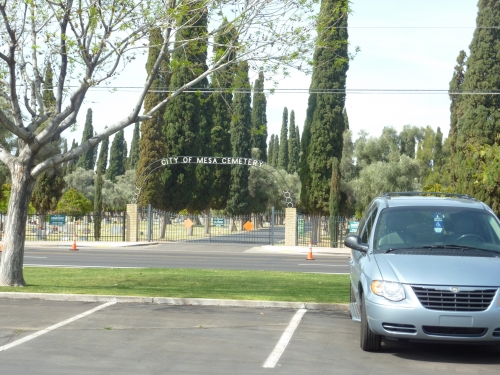
Hohokam Stadium: nothing screams Wrigleyville like city of Mesa cemetery
[/vc_column_text][/vc_column_inner][/vc_row_inner][/vc_column][/vc_row][vc_row][vc_column el_class=”container”][vc_row_inner][vc_column_inner][vc_empty_space height=”12px”][/vc_column_inner][/vc_row_inner][vc_row_inner el_class=”other_content”][vc_column_inner width=”2/3″][vc_column_text]
Architecture and Aesthetics
*Note: counts concourse aesthetics
Exterior Design: The major league standards are applied here, with a special emphasis on intimacy. In spring training, it’s really more than the façade: we need to take the exterior complex design and landscaping into account as well. Just see Camelback Ranch. Some of the top facilities are able to compete with the best major league exterior designs.
1) Is the facade aesthetically pleasing and distinctive from its peers? In other words, does the ballpark transcend its respective regional sensibilities? Do we have a ubiquitous Floridian Mediterranean exterior/Arizona Southwest stucco design, or something truly original?
2) Does the landscaping around the complex make a special effort to emphasize the exterior? Recent trends indicate that exterior landscaping is stressed above the façade.
3) Was the design novel or innovative at the time on construction?
4) Does the façade fit in with its region and its environment?
[/vc_column_text][vc_empty_space height=”12px”][/vc_column_inner][vc_column_inner width=”1/3″][vc_empty_space height=”52px”][vc_column_text]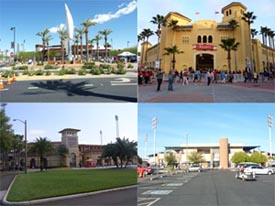
Exterior sculpture at Goodyear Ballpark; Façade at Braves complex in Disney World; Mediterranean exterior design at Joker Marchant Stadium; early primitive southwest design at Peoria Sports Complex
[/vc_column_text][/vc_column_inner][/vc_row_inner][vc_row_inner el_class=”other_content”][vc_column_inner width=”2/3″][vc_column_text]Interior Design (aesthetically): Aesthetically, Spring Training ballparks naturally fall way below the major league ballparks, but I see no reason why they shouldn’t be held to the same standards. To illustrate, compare the aesthetics of the “batters eye” of a typical spring training park to a major league park. That’s just one example. A ballpark should always be a piece of architecture. One mitigating factor is that the panoramic view of the ballpark is taken into account here, so many Arizona ballparks should benefit. We have a special emphasis on the aesthetics of the interior structure behind home plate, as opposed to the outfield design. Other than that most of the major league criteria hold true. Here are the two obvious most important factors:
1) Is the overall structure behind home plate, from the seating structure to the press box, visually distinctive, aesthetically attractive, and architecturally congruent?
2) Is the outfield design visually distinctive and aesthetically attractive? Are there elements that distinguish it from the average spring training cookie cutter facility? Continuous berms and outfield concourses beyond the field tend to be more aesthetically pleasing as well. While there is no outright punishment for not having a berm, the rating will suffer naturally here and in the concourses. Too many grapefruit league ballparks have “dead space” beyond the outfield.
3) Is intimacy stressed in the design?
4) Is there a panoramic view of something beyond the structure?
5) Is the facility well connected to its context through organic architecture?[/vc_column_text][vc_column_text]
X / 28
[/vc_column_text][vc_empty_space height=”12px”][/vc_column_inner][vc_column_inner width=”1/3″][vc_column_text]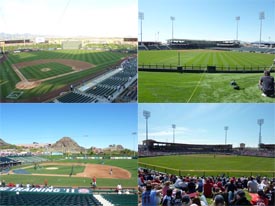
Panoramic view at Talking Stick at Salt River Fields; cross-section design at Surprise Stadium; mountain views at Tempe Diablo Stadium; cross-section design at Bright house Field
[/vc_column_text][/vc_column_inner][/vc_row_inner][/vc_column][/vc_row][vc_row][vc_column el_class=”container”][vc_row_inner][vc_column_inner][vc_empty_space height=”12px”][/vc_column_inner][/vc_row_inner][vc_row_inner el_class=”other_content”][vc_column_inner width=”2/3″][vc_column_text]
Functionality
Sightlines: Much of the same criteria are applied here, but it is much harder to screw up the sightlines in a smaller ballpark. However, a number of them have poor angles down the lines.
1) Do the seats provide unobstructed sightlines of the wide majority of the action? If they are obstructed, do they advertise as so?
2) Are the all seats down the lines oriented toward the infield in some fashion?
3) Are the berms adequately steep to provide good sightlines of most of the playing field?
4) How close are the seats to the field behind home plate and down the lines? Must new ballparks equally as close, plus or minus a couple feet, that it is often indistinguishable.
[/vc_column_text][/vc_column_inner][vc_column_inner width=”1/3″][vc_empty_space height=”52px”][vc_column_text]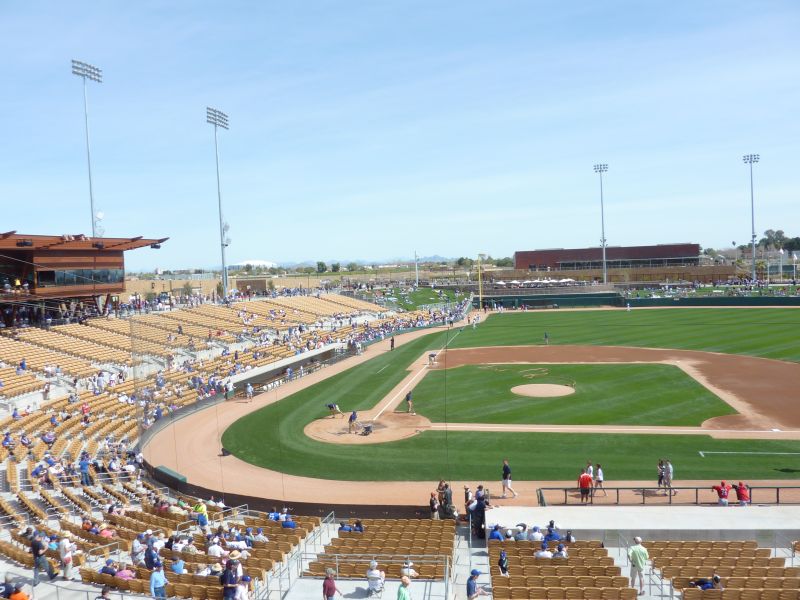
Camelback Ranch has great sightlines
[/vc_column_text][/vc_column_inner][/vc_row_inner][vc_row_inner el_class=”other_content”][vc_column_inner width=”2/3″][vc_column_text]Seat Comfort: Pretty straight forward here, much like the major league criteria. This is not too surprising considering the smaller capacities, but Camelback and Salt River seat width exceed the major league average, and meet/exceed historical standards.
1) Are all of the seats of the fold down variety? While bleachers with backs are acceptable in certain instances in the majors, they are unacceptable in this context.
2) Are they clean and well maintained?
3) Are they sufficiently wide (20-22 inches) and have legroom (33-36 inches) throughout the park?
4) Do all the seats throughout the ballpark have cup holders, which is the standard?
[/vc_column_text][/vc_column_inner][vc_column_inner width=”1/3″][vc_column_text]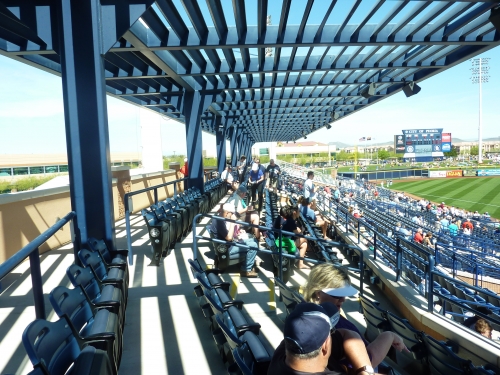
Padded club seats at Peoria Sports Complex
[/vc_column_text][/vc_column_inner][/vc_row_inner][vc_row_inner el_class=”other_content”][vc_column_inner width=”2/3″][vc_column_text]Concourses: The concourse design is easily the most underrated aspect of the ballpark. Not only is the aesthetic design highly stressed, but effective circulation is a priority to promote commerce. Just as much time goes into the concourse design as the exterior. The first three factors are equally important.
1a) Are they intuitively and continuously designed where there is seating? Or is the concourse more like a maze, where it arbitrary cuts off in certain areas? For example, Peoria and Hohokam are 360-degree systems, but there are certain areas where continuity is sacrificed and ramps and bridges must used to get from one point to another.
1b) Do they completely encircle the entire field? Do they provide open views of the field from all areas? If it’s closed from the field, is it at least open on the other side to avoid a dark and dingy feel?
1c) How wide are they? Is the space efficiently used?
1d) Note the aesthetics of the concourse.
4) Are there well appointed standing room areas throughout the concourses? The newer cactus league ballparks really take the competition to a high level, elevating the standard way over what is offered in Florida
5) Are the aisles well design and wide enough in the seating bowl?
[/vc_column_text][/vc_column_inner][vc_column_inner width=”1/3″][vc_column_text]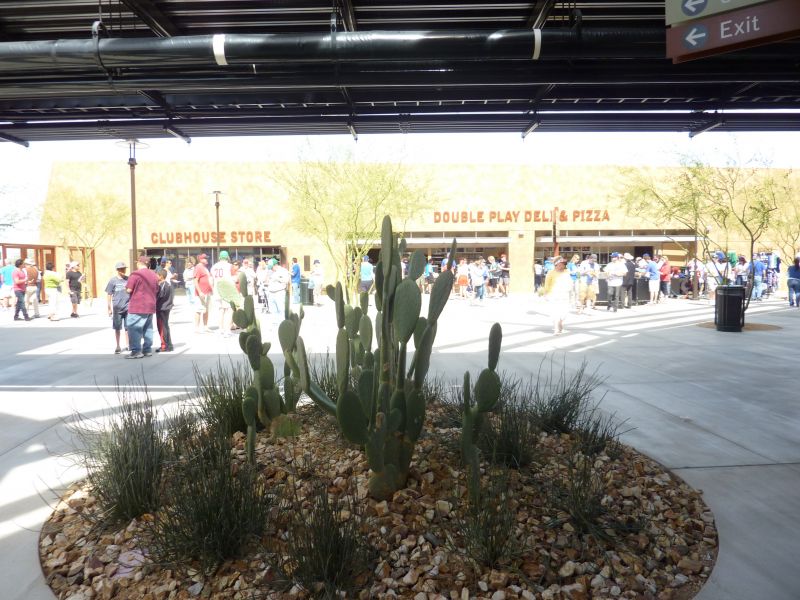
Attractive concourse at Camelback Ranch
[/vc_column_text][/vc_column_inner][/vc_row_inner][vc_row_inner el_class=”other_content”][vc_column_inner width=”2/3″][vc_column_text]Scoreboard System: While considered completely unnecessary and maybe even invasive 15 years ago, a video board is a minimum requisite for a modern spring training ballpark.
1) Size and quality of the main scoreboard system (video board, matrix board, electron line score, manual?)
2) Information displayed on the scoreboard system. The inclusion of a pitch meter, for example, is highly welcomed and almost irritatingly non-existent in the new cactus league ballparks
3) Accompanying ribbon boards in the seating bowl (rare and unnecessary, but welcomed)
4) Design of the scoreboard[/vc_column_text][vc_column_text]
X / 25
[/vc_column_text][vc_empty_space height=”12px”][/vc_column_inner][vc_column_inner width=”1/3″][vc_column_text]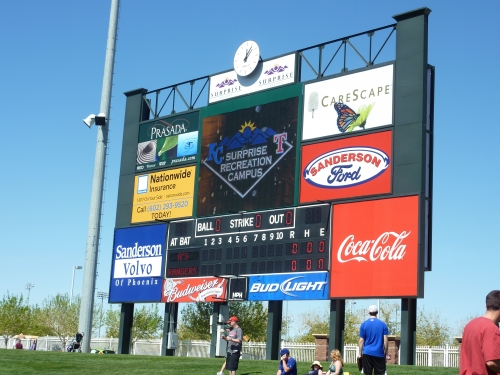
Video board at Surprise Stadium
[/vc_column_text][/vc_column_inner][/vc_row_inner][/vc_column][/vc_row][vc_row][vc_column el_class=”container”][vc_row_inner][vc_column_inner][vc_empty_space height=”12px”][/vc_column_inner][/vc_row_inner][vc_row_inner el_class=”other_content”][vc_column_inner width=”2/3″][vc_column_text]
Atmosphere
Ballpark Personality (character)/Presentation: Here’s another subjective quality I want to incorporate into these rankings. It takes a variety of objective categories (such as historical touches) of the major league criteria, but is especially vital for evaluating spring training facilities for many reasons. Primarily because so many new spring training facilities lack personality! This is somewhat inevitable with shared complexes. Major league parks are going to inevitably reflect the region, but many of the nicest new spring training ballparks are cookie cutters. First and foremost, what design features indicate that a certain team belongs in this park? Almost all of the cactus league parks fail here. Parks like jetBlue Park (Red Sox), Steinbrenner Field (Yankees), Scottsdale Stadium (Giants), and Joker Marchant Stadium (Tigers) succeed here. Basically, the ballpark needs to stand out and reflect the team that plays there.
1) What design features distinguish the facility?
2) What design features reflect the team(s) that plays in the facility and the spring training area? It should be a fusion of the local area and the region of the team. In other words, Camelback Ranch is an extraordinary ballpark, but what about it screams Dodgers or White Sox?
3) What aspects of the ballpark presentation stand out and reflect the team and/or area? Something like the Brewers Sausage Race goes in this category.
4) Note the references to team history/local history throughout the ballpark (banners, statues, plaques, ext)
5) Note signature food items that reflect the region of the team, not necessarily the quality or the selection, but simply its presence
6) Not highly stressed, but note an especially good sound system/music selection/PA announcer
[/vc_column_text][/vc_column_inner][vc_column_inner width=”1/3″][vc_empty_space height=”52px”][vc_column_text]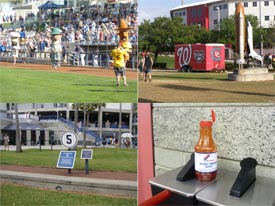
Brewers Sausage Race at Maryvale Baseball Park; spaceship at Space Coast Field; mini monument park at Steinbrenner Field; Stadium Secret Sauce at Maryvale Baseball Park. These features make the ballparks stand out.
[/vc_column_text][/vc_column_inner][/vc_row_inner][vc_row_inner el_class=”other_content”][vc_column_inner width=”2/3″][vc_column_text]Fan Support/Atmosphere (derived from fans): There’s always a certain indefinable quality to a ballpark derived by the people in it. In spring training with more generic ballparks, vibrant fans can have an especially huge impact. But like major league parks, we don’t value this as highly as you would think.
1) Attendance numbers (by percentage relative to capacity) over the life span of the park. A problem arises here with split team use facilities, but there usually little disparity. When necessary, I’ll make a distinction.
2) Reputation for being loud and producing a festive atmosphere
3) Knowledge and tradition of the fans that attend the game
[/vc_column_text][/vc_column_inner][vc_column_inner width=”1/3″][vc_column_text]
Full House at Progressive
[/vc_column_text][/vc_column_inner][/vc_row_inner][vc_row_inner el_class=”other_content”][vc_column_inner width=”2/3″][vc_column_text]Ballpark Policies/Guest Services/Ushers: This generally measures the fan friendliness of the ballpark. What do the people at the ballpark do to enhance the experience? Ballparks should ease the normal restrictions on fans for spring training and encourage mobility throughout the ballpark. A higher level of personalization is also common with the more intimate atmosphere. Other factors such as entry policies are considered as well.
1) Are fans allowed to explore non-premium areas inside (and outside, for that matter) of the ballpark before, after, and during the game? Fans should be allowed to get close to the field before or after the game. In other words, is there a giant “No Standing” sign by the bullpens or are you invited to walk around and watch?
2) Taking this into consideration, how easy is it to get autographs?
3) Do the ushers check tickets? In almost all cactus league parks, upgrading is extraordinarily easy.
4) Are there any day-to-day giveaways?
5) Are you allowed to take reasonable items, such as water and small portions of food, into gates? Do the gates open at a reasonable time before the game? i.e. 1:30-2:00 before
6) Efficiency and friendliness of ushers/venders/customer service personnel[/vc_column_text][vc_column_text]
X / 25
[/vc_column_text][vc_empty_space height=”12px”][/vc_column_inner][vc_column_inner width=”1/3″][/vc_column_inner][/vc_row_inner][/vc_column][/vc_row][vc_row][vc_column el_class=”container”][vc_row_inner][vc_column_inner][vc_empty_space height=”12px”][/vc_column_inner][/vc_row_inner][vc_row_inner el_class=”other_content”][vc_column_inner width=”2/3″][vc_column_text]
Amenities
Concessions: Almost the same criteria for major league parks are used here. The quality and selection of the food at a ballpark is very important. At ballparkratings.com, we scrutinize this category like never before. There is a high level of variation here.
1) Variety of items offered in accessible areas of the ballpark
2) Providers of the concessions offered: is all Aramark, fast food chains, or renowned local establishments. This often is a high indicator of quality.
3) Beer selection and alcohol selection
4) Quality of the food; can be difficulty to measure and is very subjective.
5) Is there a souvenir soda offered?
[/vc_column_text][/vc_column_inner][vc_column_inner width=”1/3″][vc_empty_space height=”52px”][vc_column_text]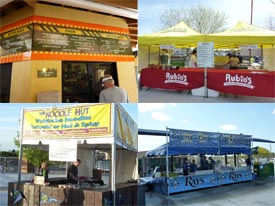
Regular concession stand at Joker Marchant Stadium; Mexican food (Rubio’s) at Hohokam Park; Asian food at Peoria Sports Complex; seafood at Charlotte Sports Complex
[/vc_column_text][/vc_column_inner][/vc_row_inner][vc_row_inner el_class=”other_content”][vc_column_inner width=”2/3″][vc_column_text]Premium Seating/Party Decks: The revenue generating premium seating selection certainly doesn’t have the presence it has in major league ballparks, but has become a fixture since the late 90s. Unlike the major league parks, premium seating serves as more of a gesture to large groups, fans with connections to the ballclub, and local organizations than a fiscal necessity for a viable ballpark. The Yankees at Steinbrenner Field are the exception here, as their 12 luxury suites and Brighthouse Dugout Club are a relatively nice cash cow, with the latter generating as much as $22,800 for 8 seats per year (so basically meaning month) from various Tampa Bay corporations.
1a) Quantity and quality of luxury suites and service offered
1b) Location and quality of party decks throughout the outfield and down the lines.
1c) Quantity and quality of any club seating, whether presented in the guise of a mezzanine “club level” or mezzanine patio which have de facto club seats, fenced-off infield boxes, any other differentiated seats with amenities such as padded seats and personal in-seat service, or even an actual ultra premium “dugout club” behind home plate with a private dining area, free food, and free drinks (only Steinbrenner Field offers this, a model which popular teams such as the Red Sox and Cubs should/should’ve emulated. To be fair, the Dodgers/White Sox tried this concept at Camelback Ranch in 2009 (“Home Plate Club”) and it failed miserably, but that’s only because they did it wrong which I’ll explain later).
[/vc_column_text][/vc_column_inner][vc_column_inner width=”1/3″][vc_column_text][/vc_column_text][/vc_column_inner][/vc_row_inner][vc_row_inner el_class=”other_content”][vc_column_inner width=”2/3″][vc_column_text]Restaurants/Bars/Sitting Areas: While not too big of a deal, spring training ballparks with sit down bars (think outfield Tiki Bars in Clearwater, Port St. Charlotte, and Bradenton), benches/tables/sitting areas along the concourses, and even quasi restaurants (think Café 54 in Sarasota) are extremely welcome amenities. It’s really annoying when you get something at a concession stand and realize there’s no place or not many places to sit down and eat/drink it other than your seat! Note this does not take club and private party deck seating areas into account.
[/vc_column_text][/vc_column_inner][vc_column_inner width=”1/3″][vc_column_text][/vc_column_text][/vc_column_inner][/vc_row_inner][vc_row_inner el_class=”other_content”][vc_column_inner width=”2/3″][vc_column_text]Entertainment/Miscellaneous Amenities: The ballpark experience at spring training is what keeps casual fans coming. Just ask the folks in Bradenton in 2013, who are attempting to totally revamp the vibe and counter the perception that McKechnie Field is for old-timer Pirate fans, courting multiple generations of younger fans. Considerations:
1) Activities for the kids: mini ballfields, playgrounds, speed pitches, batting cages, video games, etc.
2) Other entertainment in the ballpark before, after, and during the game
3) In between inning games and such?
4) Team stores[/vc_column_text][vc_column_text]
X / 25
[/vc_column_text][vc_column_text]
BONUS: 1-10
[/vc_column_text][vc_empty_space height=”12px”][/vc_column_inner][vc_column_inner width=”1/3″][vc_column_text][/vc_column_text][/vc_column_inner][/vc_row_inner][vc_empty_space][/vc_column][/vc_row]